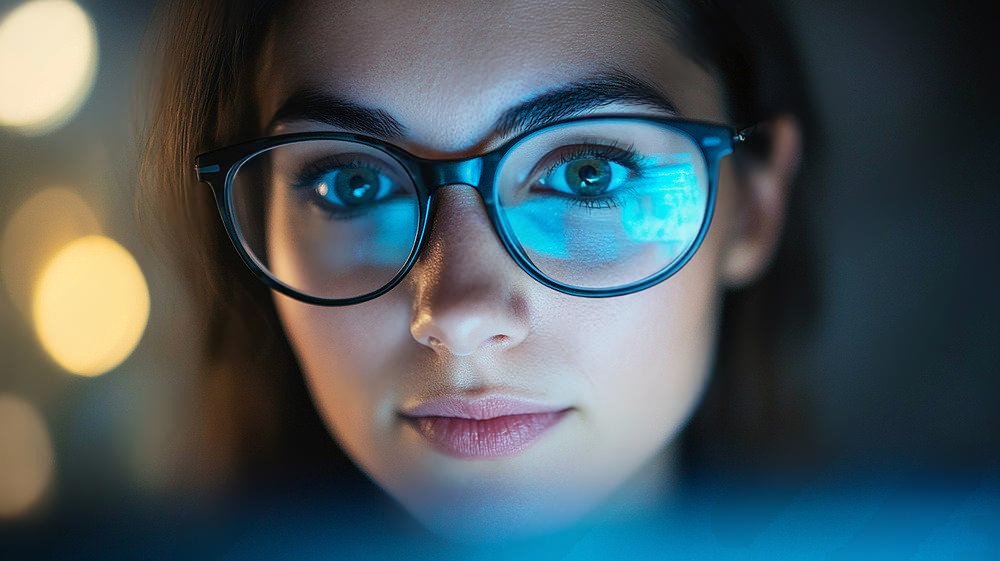What’s your screen time like on a daily basis? With technology being an integral part of our lives, the amount of time spent in front of screens tends to increase. If you find yourself frequently squinting or feeling fatigued after hours of screen time, you might have heard about blue light glasses and their purported benefits. Let’s dive into understanding their purpose, role in eye health, and what might be best for you.

Table of Contents
ToggleUnderstanding Blue Light
Blue light is a high-energy visible light that boosts alertness and helps regulate sleep cycles. We encounter blue light naturally from the sun, but electronic devices like screens from computers, smartphones, and TVs emit significant amounts of it too.
While blue light helps maintain your health by regulating your circadian rhythm, recent concerns have emerged regarding its potential effects on eye health, particularly with the surge of screen use over recent years.
The Concerns Over Blue Light
Overexposure to blue light is thought to lead to digital eye strain, which can manifest as discomfort, dry eyes, and headaches. Some studies even suggest a connection between excessive blue light exposure and long-term damage to the eyes. Although research is ongoing, taking proactive measures to protect your vision can be essential.
Purpose of Blue Light Glasses
So, what exactly are blue light glasses, and how do they work? These glasses are specifically designed to filter out harmful blue light emitted by screens, potentially minimizing the side effects associated with prolonged screen time.
How They Work
Blue light glasses typically come with a special coating that reduces the intensity of blue light that reaches your eyes. By decreasing the amount of blue light entering your eyes, these glasses may help reduce eye strain, dry eyes, and headaches that many people experience during long hours in front of screens.
For those who have trouble sleeping, wearing these glasses, especially in the evening, might even help improve sleep quality by regulating melatonin production.
The Testing Overview
With various options available, it’s vital to identify which blue light glasses work best for you. To help with this, a selection of 24 pairs of blue light glasses were tested over a week. The evaluation covered several factors, including:
| Factor | Description |
|---|---|
| Fit | How well the glasses conformed to the shape of your face. |
| Comfort | The overall comfort during prolonged use. |
| Clarity | The clarity of vision provided by the lenses. |
| Effectiveness | The extent to which the glasses alleviated eye strain and other symptoms. |
| Value | The cost relative to the benefits experienced. |
The Findings
After testing, the results showed a mixture of effectiveness among the glasses evaluated. Many users reported varying degrees of relief from symptoms, while others found little difference. This mixed evidence indicates that, like most products, results can vary based on individual experiences.
Mixed Evidence in Research
While wearing blue light glasses makes sense to some, research on whether they genuinely alleviate discomfort has yielded mixed results. Some scientific studies support the idea that blue light glasses can reduce symptoms of eye strain and fatigue, while others question their effectiveness.
User Experiences
It’s important to note that your experience may not align with the scientific consensus. Many users have reported noticeable improvements in comfort and decreased headaches after using blue light glasses. Testimonials frequently highlight how these glasses have made working long hours more bearable.

Top Recommendations
If you’re considering investing in a pair of blue light glasses, here are some of the best options currently available, based on user feedback and testing results:
Best Overall: Benicci Stylish Blue Light Blocking Glasses
These glasses are lightweight, durable, and comfortable without any noticeable tint. They come with a blue light tool to help you see how well they work.
Best for Working: Felix Gray Jemison
If you spend significant time in front of screens, these glasses are your best friend. They feature clear, non-reflective lenses that promote comfort during long working hours.
Best for Eye Strain: Warby Parker Beauford Glasses
With prolonged use, many users noted that these glasses significantly reduced eye strain and fatigue. They combine style with eye health.
Best Budget: LensDirect Emory
Affordability is key for many, and these glasses offer an excellent value without compromising comfort. You can find both prescription and non-prescription options.
Most Versatile: Warby Parker Thurston
These glasses can be customized for various prescriptions, promoting comfort and clarity while ensuring you look stylish.
Best for Headaches: Peepers by PeeperSpecs Shine On
If screen time leads to regular headaches, these glasses may help reduce their occurrence, providing relief during those long hours.
Best for Reading: Caddis Miklos
Bold and stylish frames that reduce eye strain during reading sessions, though they may require adjustments for the perfect fit.
Best for Gamers: Gunner Razer
Specifically designed for gaming environments, these glasses not only protect your eyes but also enhance your gaming experience.
Usage Tips for Your Eye Health
Apart from wearing blue light glasses, there are simple habits you can incorporate into your daily routine to better protect your eyes during prolonged screen time.
Take Regular Screen Breaks
The 20-20-20 rule is a well-known guideline where every 20 minutes, you should look at something 20 feet away for at least 20 seconds. This practice helps relieve eye strain and fatigue and gives your eyes a much-needed rest.
Adjust Screen Brightness
Your screen’s brightness can have a significant impact on eye comfort. Ensure your screen brightness matches your surroundings. If it’s too bright or too dim, your eyes will have to work harder, leading to discomfort.
Maintain Proper Distance
The distance between your eyes and the screen should be at least an arm’s length. This will help reduce strain on your vision. Additionally, ensuring your screen is at eye level can prevent neck strain too.
Use Artificial Tears
If you experience dry eyes frequently, consider using lubricating eye drops to keep your eyes hydrated. This is especially helpful in dry environments or when working at a desk for extended periods.
Wear Sunglasses Outdoors
While blue light glasses are beneficial indoors, don’t forget about protecting your eyes from natural sunlight too. Wearing sunglasses that block blue light when you’re outdoors can help safeguard your vision.
Conclusion
Determining whether blue light glasses are right for you can depend on your individual experiences and preferences. While research shows mixed evidence regarding their effectiveness, many users have reported improvements in eye strain and headaches.
With various options available, from stylish designs to budget-friendly picks, you can find a pair that suits your needs and style. By combining the use of blue light glasses with good screen habits, you’ll be taking a significant step towards better eye health and comfort in a screen-filled world.
Taking action today means your eyes can enjoy the benefits of both technology and comfort, keeping you fresher and more focused as you go about your daily activities. By understanding the purpose and potential benefits of blue light glasses, you’re one step closer to achieving eye health in the digital age.




